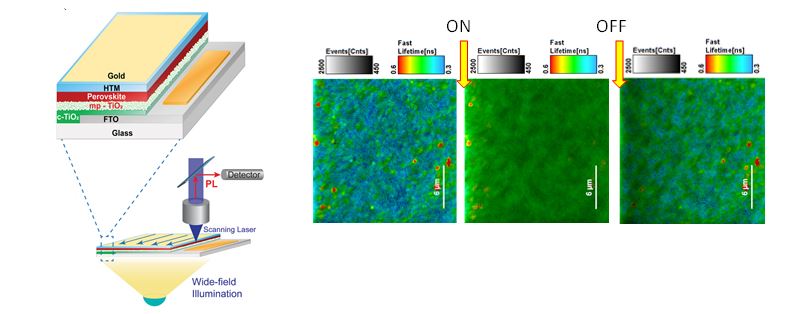Video Article Open Access
Dynamic Effects of Mobile Ions in Halide Perovskites
Xiaoming Wen
Center for Translational Atomaterials, Swinburne University of Technology, Hawthorn, VIC 3122, Australia
Vid. Proc. Adv. Mater., Volume 3, Article ID 2203269 (2022)
DOI: 10.5185/vpoam.2022.03269
Publication Date (Web): 31 Jul 2022
Copyright © IAAM
Graphical Abstract

Abstract
Metal halide perovskites have emerged as the most attractive materials for photovoltaics and optoelectronics because of their superior optoelectronic properties and low-cost fabrication. Quick increased conversion efficiency of solar cells as well as high performance of LEDs, detectors and lasers ensure halide perovskites the most promising for next generation of photovoltaic and optoelectronic industry for flexible and low-cost devices. Relative to the quick progress in devices of photovoltaic, optoelectronic and photonic applications, however, the fundamental understanding for material and device physics is significantly lagged. Previously people considered the general properties, such as long carrier lifetime and long diffusion length, high absorption and low binding energy, can be responsible for their superior performance. Obviously, these are not sufficient. The fundamental difference of halide perovskites from the conventional semiconductors is their mixed ionic-electronic properties which make perovskites superior in photovoltaics and photonics. Ionic-electronic interaction in halide perovskites is intimately correlated with their performance and stability. The anomalous phenomena observed in halide perovskites, such as current-voltage (I-V) hysteresis, defect tolerance and phase segregation, have been intensively investigated and suggested to be relevant to mobile ions. To date, the most fundamental question still keeps elusive: what makes perovskites so superior to the conventional semiconductors? The comprehensive fundamental understanding on the interaction between mobile ions and charge carriers is critically important for commercialization and further improvement of halide perovskite photovoltaics and photonics but is still not available so far. In this talk I present our recent investigations for the dynamics of mobile ions in halide perovskite by combining steady state, time-resolved spectroscopy and micro-spectroscopy. Advanced time-resolved micro-spectroscopic techniques are powerful tools to investigate the energy relaxation processes of the excited carriers and mobile ions in various material systems. It is confirmed that mobile ions have significantly impact on the carrier dynamics, with much slow timescale up to hours, which provides an effective method to investigate the interaction between mobile ions and charge carriers. Mobile ion activation, migration and accumulation result in a much slow process in milliseconds to hours, which is closely relevant to the characteristic hysteresis in I-V measurement and light soaking effects [1,2]. We monitor nanoscale PL/TRPL evolution in fully operational solar cells under the light soaking condition. Using highly sensitive micro-spectroscopic techniques, we also image the mobile ion diffusion and substitution in mixed halide perovskites [3,4].
Keywords
Mobile ions, halide perovskites, time-resolved micro-spectroscopy, photovoltaics.
References
- Wen, X. M.; Ho-Baillie, A.; Huang, S. J.; Sheng, R.; Chen, S. et al. Nano Lett., 2015, 15, 4644.
- Zheng, F.; Chen, W.; Bu, T.; Ghiggino, K. P.; Huang, F. et al. Adv. Energy Mater., 2019, 1901016.
- Deng, X.; Wen, X. et al. Nano Energy, 2018, 46, 356.
- Chen, W.; Gan, Z.; Green, M. A.; Jia, B.; Wen, X.; Small Methods, 2021, 5, 2000731.
- Li, W.; Rothmann, M.; Zhu, Y. et al. Nature Energy, 2021, 6, 624-632.
Biography
Xiaoming Wen is currently a senior research fellow at Swinburne University of Technology in Australia. He was awarded PhD in 2007 on ultrafast spectroscopy from Swinburne University. He has performed research at University of New south Wales and University of Melbourne in Australia, and Academia Sinica in Taiwan, focusing on photophysics and carrier dynamics of photovoltaic, photocatalytical materials and nanomaterials. He was appointed as full professor at Yunnan University in China. He has set up several state-of-the-art spectroscopic experiments and completed some challenging spectroscopic measurement. He is leading expert for ultrafast time-resolved spectroscopy and micro-spectroscopy for characterization of photovoltaic and photocatalytic materials, and electron/exciton/phonon dynamics in nanomaterials. Recent years, he leads a group for photophysical investigation of halide perovskites and relevant devices. The dynamic transition of photon-carrier or electron-photon is the core process for photovoltaic, photocatalytical and emission/detector, and intimately correlated to the structure and improvement of the device applications. Ultrafast micro-spectroscopy provides powerful tool for deep fundamental understanding of the dynamic processes.
During the research, he has published more than 180 refereed journal papers in highly impacted journals, including 8 ESI highly cited papers (top 1%) and 30 top prestigious journals (IF > 10), such as Nature Materials, Nature Energy, Nature Communications, Advanced Energy Materials and Nano Letters. His outstanding research performance has been recognized, as awarded Vice-Chancellor's Research Excellence Awards at Swinburne University of Technology in 2019, as well as 2019 Faculty of Science Engineering and Technology Research Award at Swinburne University and 2015 Staff Excellence Awards in Research in Faculty of Engineering at University of New South Wales. He is also editorial board member for Scientific Reports, Frontiers in Chemistry and Frontiers in Physics.
Video Proceedings of Advanced Materials

Upcoming Congress



